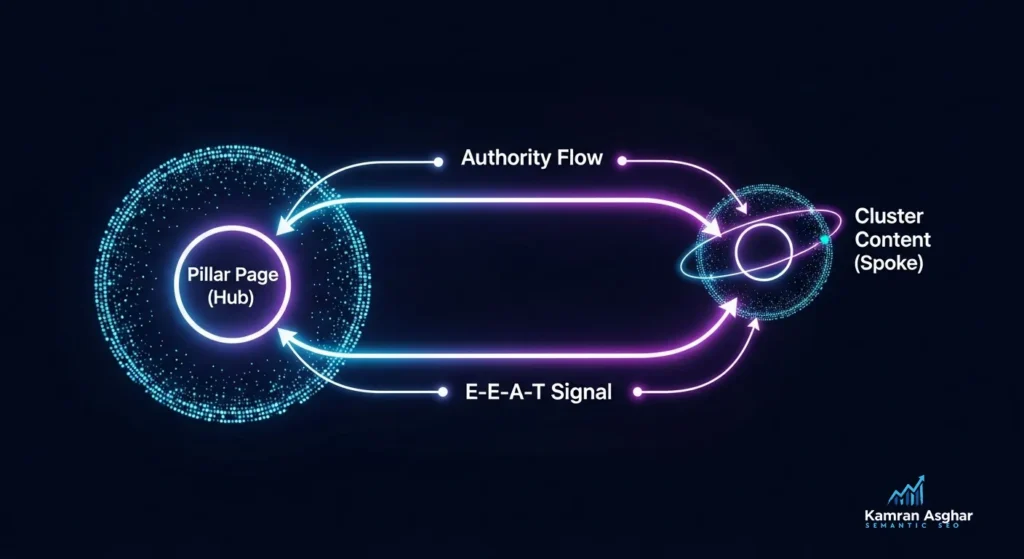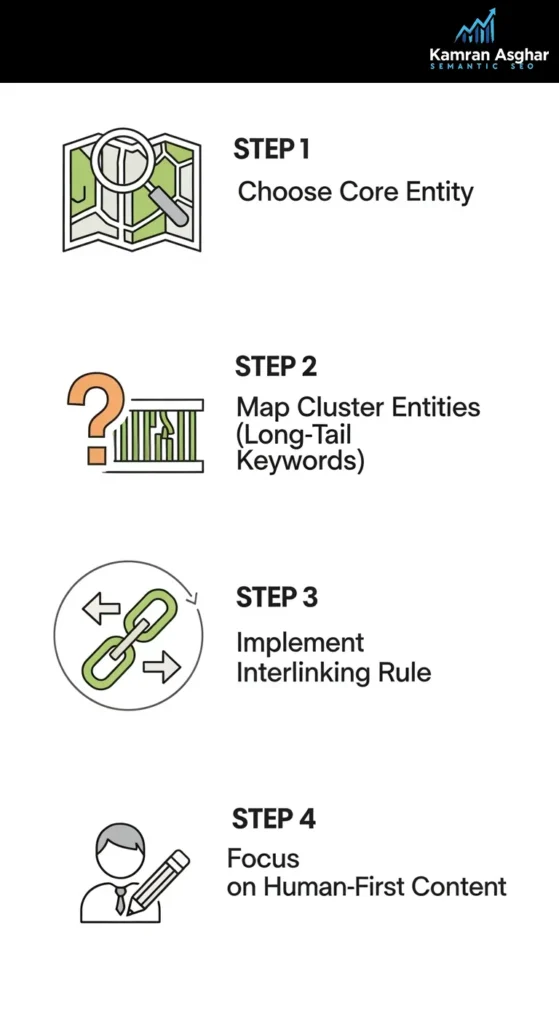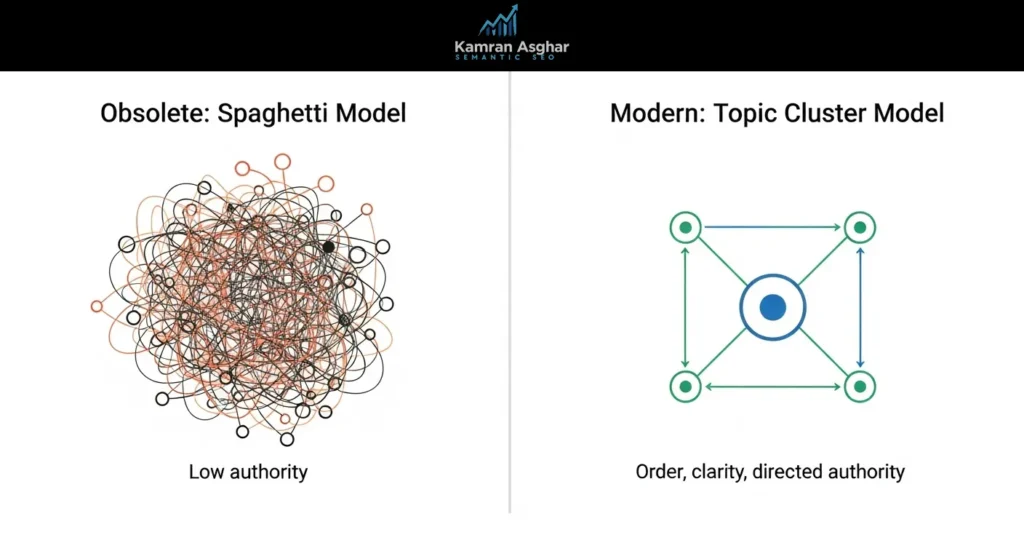The entire landscape of Search Engine Optimization (SEO) has changed. If you are still trying to rank high on Google by targeting singular, isolated keywords, you are losing the game. That approach is obsolete. The modern search algorithm, which relies heavily on Natural Language Processing (NLP) and semantic search, no longer cares about single keywords; it cares about Topical Authority.
This means that to succeed, you must adopt the Topic Cluster Model, a concept first pioneered by HubSpot. I can tell you that this is the single most effective way to signal to Google that your website possesses the comprehensive Experience, Expertise, Authority, and Trust (E-E-A-T) required to rank. Your content should always be written from a first-person perspective, delivering actionable insights based on proven results.
What Exactly is the Topic Cluster Model in SEO?
The topic cluster model, also known as the Hub and Spoke model, is a revolutionary approach to site architecture and content creation. It moves away from the messy, disorganized “spaghetti model” of content where every page is a standalone island.
What Are the Three Essential Components?
To successfully implement a topic cluster, you need three interconnected elements. Think of this structure like a central nervous system for your content, where authority and relevance flow freely between nodes:

- The Pillar Page (The Hub): This is a single, long-form, comprehensive piece of content that provides a broad, high-level overview of a major topic (e.g., “The Ultimate Guide to Content Marketing”). It is designed to target a broad, high-volume keyword and only briefly introduces the many subtopics.
- Cluster Content (The Spokes): These are individual, more focused articles that dive deep into one specific subtopic mentioned in the Pillar Page (e.g., “How to Conduct Keyword Research for Content Marketing”). Each piece targets a more specific, long-tail keyword and provides definitive, in-depth value.
- Internal Linking Structure: This is the flow of authority. Crucially, the Pillar Page links out to every piece of Cluster Content, and every piece of Cluster Content links directly back to the Pillar Page using a relevant anchor text.
Why Must I Use Topic Clusters to Establish Authority?
The core goal of a topic cluster is not just to rank for one term; it is to dominate an entire subject area. This directly aligns with Google’s demand for Topical Authority. When you cover a subject comprehensively, you tell the search engine: “We know everything about this topic.” In my consulting experience, this strategy has consistently led to exponential traffic growth by focusing on the overall semantic web of content. The goal is to establish your website as a definitive source, a process detailed comprehensively in this Conductor guide.
How Does the Model Boost E-E-A-T?
Topic clusters are the architectural roadmap to demonstrating high E-E-A-T:
- Signals Expertise: By linking out to 10-20 cluster articles, you prove that you have not just general knowledge, but in-depth expertise across all facets of a topic. This is a powerful signal that siloed content simply cannot replicate.
- Improves User Experience: A clear structure allows users to navigate easily between broad and specific concepts. Lower bounce rates and increased time on site are strong Trust signals for Google.
- Prevents Cannibalization: When you group semantically similar content, you clearly define which page (the Pillar) should rank for the broad term and which pages (the Clusters) should rank for the long-tail terms. This prevents your own pages from competing against each other.
How Do I Build a High-Performing Topic Cluster?
I recommend a systematic, four-step process. You must be strategic and map this out before you write a single word.
1. Choose Your Core Entity (The Pillar Topic)

Your topic must be broad enough to house at least 10–20 subtopics but narrow enough to be relevant to your business model.
- Look for Breadth: The Pillar should target a highly-searched term with strong informational intent (e.g., “Search Engine Optimization” or “Financial Planning”) and meet the user’s high expectations for quality, as outlined in Google’s guidelines.
- Use the Alphabet Soup Technique: Plug your broad term into a search tool and use the alphabetical suggestions (A-Z) and People Also Ask (PAA) sections to immediately identify the most common sub-entities and relevant questions.
2. Map Your Cluster Entities (Subtopics)
Each Cluster article should cover a distinct subtopic. Focus on answering every related question a user might have.
- Target Long-Tail Keywords: Each cluster page should focus on a long-tail keyword that maps to a specific search intent (e.g., “How to audit your site architecture” for the “SEO” pillar).
- Address Specific PAA Questions: Directly turn common PAA questions into your cluster titles: Is a topic cluster better than a silo structure?
3. Implement the Interlinking Rule
This is the non-negotiable step. The link structure must be deliberate, consistent, and utilize clear anchor text.
- Pillar-to-Cluster: Link from the Pillar Page using the exact title of the Cluster article as the anchor text (e.g., “…you can learn more about how to Build an Internal Linking Structure…”).
- Cluster-to-Pillar: Every Cluster article must have a contextual link in the first few paragraphs that links back to the main Pillar Page, also using a relevant anchor text.
4. Focus on Human-First Content
Remember the ultimate rule: Write for Humans First, Optimize for Crawlers Second. The depth and quality of the content are what secure high rankings. Ensure your articles are genuinely definitive guides, full of actionable advice and concrete examples.
Frequently Asked Questions (PAA Integration)
Does Google Officially Endorse Topic Clusters?
While Google has not explicitly named the “Topic Cluster Model,” the core concepts align perfectly with their guidance on building a clear site hierarchy, demonstrating topical breadth, and improving user navigation. They actively reward sites that comprehensively cover a subject.
Is a Topic Cluster better than a Silo Structure?
Yes, absolutely. The traditional silo structure often creates dead-end pages and relies on navigation menus, which do not pass authority as effectively. The Topic Cluster model is a more modern, dynamic silo that uses contextual internal links to actively signal to search engines the exact semantic relationship between all your content.
What is the ideal length for a Pillar Page?
Pillar pages must be comprehensive. I recommend they are 3,000+ words in length. They should be definitive guides, often featuring a Table of Contents at the top to enhance user experience and satisfy jump-links in the SERPs. The goal is to broadly answer the primary question while serving as the authoritative gateway to all related subtopics.
Final Words
The move from keyword-centric SEO to Topical Authority is complete. If your goal is to rank for competitive terms and be recognized as a true leader in your industry, you must organize your content using the Topic Cluster Model. It is the proven way to structurally reinforce your site’s E-E-A-T signals. Stop chasing fleeting keywords and start building a definitive, authoritative library of content.
If you need any help mapping out your first Pillar Page or structuring your existing content into a logical, high-impact Topic Cluster, I’m happy to help you conduct a full semantic audit and consultation.

